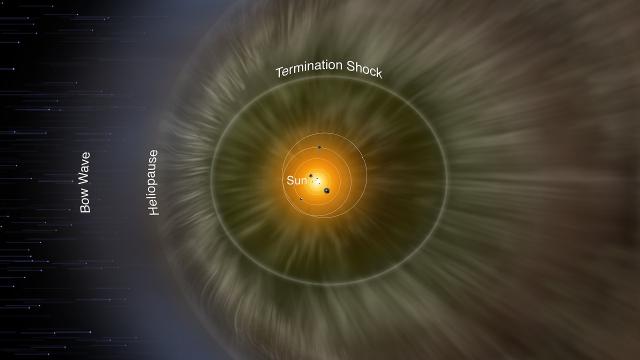The Voyagers 1 and 2 spacecraft measured the Sun sending a pulse like a “tsunami” into the interstellar medium, according to a new paper.
The pulse, called a global merged interaction region, comprised solar emissions that combined and then crashed into the boundary between the region of the Sun’s influence and interstellar space. Since the Voyager missions were on either side of the boundary during this time, scientists were able to calculate properties of the disturbance, as well as previously unmeasured properties of the region of space called the heliosheath. It was a lucky series of events.
“I’m so thankful about the timing,” Jamie Rankin, the study’s first author and a postdoctoral researcher at Princeton University, told Gizmodo. “If we didn’t have [the Voyager missions] in these different environments, then we wouldn’t have been able to do this, and if the Sun hadn’t put out this huge event at the that time, then we wouldn’t have been able to do this.”
Particles from the Sun influence a region called the heliosphere, which encompasses the solar system and space stretching far past Neptune. Past a region called the terminal shock, the winds slow below the local speed of sound, and an understudied, less-dense region of turbulence and low magnetic fields called the heliosheath begins. Farther out lies the heliopause, which separates these slower particles from the particles of the interstellar medium. The heliopause is the farthest region influenced by the Sun’s particles, though the Sun’s gravity affects objects even farther out.
Scientists analysing data from the Voyager missions found that in late 2012, while Voyager 2 was in the heliosheath, it measured a disturbance in the particles striking it from outside the solar system as they responded to a passing pressure wave.
Approximately 130 days later, Voyager 1, which was already outside the heliopause, measured a pulse with “remarkable similarity” in the interstellar medium, according to the paper published recently in The Astrophysical Journal.
This informed the scientists that a global merged interaction region (GMIR), a disturbance made up of various solar particle ejections combining into a larger structure with intense magnetic fields and higher pressures, had passed Voyager 2 in the heliosheath like a “tsunami,” said Rankin, and then smacked into the heliopause. Then, like a vibrating membrane of a speaker, the heliopause re-transmitted the wave onward into interstellar space with a similar wave shape but slightly different effects on the local particles.
The fact that the Voyager missions were in separate regions of space when the GMIR arrived allowed the researchers to calculate properties of the heliosheath that had never been directly measured. This includes the local speed of sound as well as the pressure. According to the team’s calculations, this pressure comes partly from solar particles, partly from the neutral particles that fill the interstellar medium, and the rest from a yet-to-be-determined source.
One researcher not involved with the study thought the measurement was exciting and important. “This is a solid scientific result, and I believe the first time they’ve seen this correlated event” between the two probes, Herbert Funsten, a research scientist at Los Alamos National Lab, told Gizmodo. He was excited to see the analysis of more of these GMIR events that the Voyager probes have measured, and see how these measurements compare with NASA’s Earth-orbiting Interstellar Boundary Explorer (IBEX) mission.
The study has its limitations. For one, Voyager 1’s plasma-measuring instrument wasn’t working, so the researchers had to assume the interstellar temperature for their calculations. There are other such GMIR events that the researchers would like to explore, and ideally we’ll one day send another mission to this region of space.
Voyagers 1 and 2 launched in 1977 and are now 22 billion and 18 billion kilometres from Earth, respectively, making them the most distant human-made objects ever.
